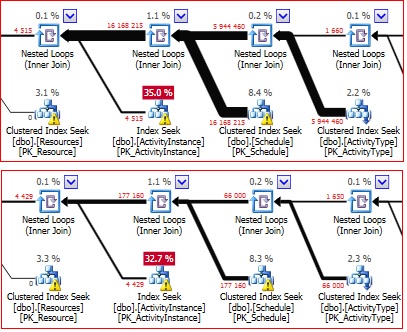Same Execution Plan different stats
-
October 19, 2018 at 10:39 am
DesNorton - Thursday, October 18, 2018 1:54 PManvegger - Thursday, October 18, 2018 1:45 PMJeffrey Williams 3188 - Thursday, October 18, 2018 1:15 PMIf you look at the plans - this is telling you that the actual number of rows it retrieved from the ActivityInstance is 4515 but it had to 'read' 16168215 to get that result. On the other database the actual rows is 4429 but it only had to read 177160 rows to get that result.That is correct: the question is
how
217 136 actual records in Table ActivityInstance have been 'read' 16 168 215 times in one database (Database D) and
219 209 actual records in the same table ActivityInstance have beed 'read' only 177 160 times in the other (Database A) using the same index and similar statistics.I don't see that logic processed from the execution plan.
The extra reads are due to the extra records in the Schedule and ActivityType tables

- I may have missed something, but from the plan it appears that the 2nd largest I/O is from the table dbo.ActivityType. However, the query does not appear to reference dbo.ActivityType.
The largest I/O is from dbo.Schedule. It might help to pre-filter the Schedule table in the WHERE clause by addingAND s.LicenseeId = 'app1347'Apologies. I misread the existing where clause.- Can we see the index definitins on these 2 tables. That may assist in providing better joins and/or predicates. the code below will extract the index information.
SELECT
[TableName] = t.name
, [idxName] = si.name
, [idxType] = si.type_desc
, [isPK] = si.is_primary_key
, [isUNQ] = si.is_unique
, si.is_disabled
, [Columns] = LTRIM(RTRIM(
STUFF(
( SELECT ',' + ac.name + CASE WHEN sic.is_descending_key = 1 THEN N' DESC' ELSE N'' END
FROM sys.index_columns sic
INNER join sys.all_columns ac
ON ac.object_id = t.object_id
AND ac.column_id = sic.column_id
WHERE sic.object_id = si.object_id
AND sic.index_id = si.index_id
AND sic.is_included_column = 0
ORDER BY sic.key_ordinal, sic.index_column_id
FOR XML PATH('')
), 1, 1, '')
))
, Includes = LTRIM(RTRIM(
STUFF(
( SELECT ',' + ac.name
FROM sys.index_columns sic
INNER join sys.all_columns ac
ON ac.object_id = t.object_id
AND ac.column_id = sic.column_id
WHERE sic.object_id = si.object_id
AND sic.index_id = si.index_id
AND sic.is_included_column = 1
ORDER BY sic.key_ordinal, sic.index_column_id
FOR XML PATH('')
), 1, 1, '')
))
, si.filter_definition
FROM sys.schemas s
INNER JOIN sys.tables t on t.schema_id = s.schema_id
INNER JOIN sys.indexes si on si.object_id = t.object_id
WHERE t.[type] = 'U' -- USER_TABLE
AND s.name = 'dbo'
AND t.name IN ('Schedule' , 'ActivityType')
GROUP BY s.name, t.name, si.name, si.type_desc, si.is_primary_key, si.is_unique, si.is_disabled
, t.object_id, si.object_id, si.index_id, si.filter_definition
ORDER BY s.name, t.name, si.is_primary_key DESC, si.name; -
October 19, 2018 at 12:12 pm
Many thanks Dear DesNorton for your time:
As I mentioned before all the objects are identical (now) after I added a missing (unneeded) indexActivityType PK_ActivityType CLUSTERED 1 1 0 LicenseeId,ActivityTypeId NULL NULL
ActivityType ix_ActivityType_ExternalId NONCLUSTERED 0 0 0 LicenseeId,ExternalId NULL NULL
Schedule PK_Schedule CLUSTERED 1 1 0 LicenseeId,LocationId,ScheduleId NULL NULL
Schedule IDX_licensee_enabled_uresource NONCLUSTERED 0 0 0 LicenseeId,IsEnabled,UResourceId,CampaignId,ProgramId LocationId,ActivityId,ScheduleId,UScheduleId NULL
Schedule IDX_Schedule_LicenseeUResID NONCLUSTERED 0 0 0 LicenseeId,UResourceId NULL NULL
Schedule IDX_ScheduleLicLocSchURes NONCLUSTERED 0 0 0 LicenseeId,LocationId,ScheduleId,UResourceId NULL NULL
Schedule IX_N_ScheduleUResUsch NONCLUSTERED 0 0 0 LicenseeId,IsEnabled,CampaignId,ProgramId,UResourceId,UScheduleId ActivityId,ScheduleId NULL -
October 19, 2018 at 12:21 pm
DesNorton - Friday, October 19, 2018 10:39 AM- I may have missed something, but from the plan it appears that the 2nd largest I/O is from the table dbo.ActivityType. However, the query does not appear to reference dbo.ActivityType.
Yes you are correct DesNorton: In both case scenarios there is a VIEW (once have been introduced to replace the legacy table)
CREATE VIEW [dbo].[Activity] WITH SCHEMABINDING
AS
SELECT typ.[LicenseeId]
,[LocationId]
,[ActivityId]
,[ExternalId]
,[ActivityName]
,ins.[IsEnabled]
,[Capacity]
,[Description]
,[IsPaymentEnabled]
,[PaymentDescription]
,[GLCode]
,[MaxAttendeesPerAppt]
,[DefaultRecoveryTime]
,[ResourceAllocationRuleId]
,[IsOverbookingEnabled]
,[OverbookingRuleId]
,[ScheduleTypeId]
,[RepeatQuestionsForAttendees]
,ins.[IsDeleted]
,ins.[DeletedDate]
,[IsWorkFlowEnabled]
,[ApplyDateRange]
,[StartDate]
,[EndDate]
,[PropertyGroupId]
,[ApptGroupTypeId]
,[AllocateSamePrimaryResource]
,[AllocateSameSecondaryResources]
,[PriceRuleId]
,[CancellationPeriodRuleId]
,[IsWaitListEnabled]
,[IsCustomerCommentEnabled]
,[IsClientCommentEnabled]
,[IsApptCommentEnabled]
,[UActivityId]
,[AllowConcurrentAppointments]
,[IsEventSeries]
,[SeqNumber]
,[DisableEWSConnection]
,[ResourceDisplayRuleId]
,[IsWebConference]
FROM dbo.ActivityType typ
INNER JOIN dbo.ActivityInstance AS ins ON typ.LicenseeId = ins.LicenseeId AND typ.ActivityTypeId = ins.ActivityTypeIdGO
-
October 19, 2018 at 3:09 pm
What do you see if you run this in both dbs? I'm not optimistic, not even sure this will run w/out you fixing it first. But maybe you'll see difference between A and D?
--try to see working set expansion as we join from Location to the Activity view
SELECT COUNT (l.LicenseeId) as Count_Location_LicenseeId_app1347
FROM Licensee li
INNER JOIN Users u
ON u.LicenseeId = li.LicenseeId
AND u.UserId = 1
JOIN UserResourceManagement urm
ON urm.LicenseeId = u.LicenseeId
AND urm.UserId = u.UserId
JOIN Campaign c
ON c.LicenseeId = u.LicenseeId
AND c.CampaignId = -1
JOIN Program_table pg
ON pg.LicenseeId = u.LicenseeId
AND pg.LocationId = c.LocationId
JOIN Location l
ON l.LicenseeId = u.LicenseeId
WHERE li.ExternalId = 'app1347'SELECT COUNT (a.LicenseeId) as Count_ActivityType_app1347
FROM Licensee li
INNER JOIN Users u
ON u.LicenseeId = li.LicenseeId
AND u.UserId = 1
JOIN UserResourceManagement urm
ON urm.LicenseeId = u.LicenseeId
AND urm.UserId = u.UserId
JOIN Campaign c
ON c.LicenseeId = u.LicenseeId
AND c.CampaignId = -1
JOIN Program_table pg
ON pg.LicenseeId = u.LicenseeId
AND pg.LocationId = c.LocationId
JOIN Location l
ON l.LicenseeId = u.LicenseeId
JOIN ActivityType a
ON a.LicenseeId = u.LicenseeId
WHERE li.ExternalId = 'app1347'SELECT COUNT (a.LicenseeId) as Count_Activity_app1347
FROM Licensee li
INNER JOIN Users u
ON u.LicenseeId = li.LicenseeId
AND u.UserId = 1
JOIN UserResourceManagement urm
ON urm.LicenseeId = u.LicenseeId
AND urm.UserId = u.UserId
JOIN Campaign c
ON c.LicenseeId = u.LicenseeId
AND c.CampaignId = -1
JOIN Program_table pg
ON pg.LicenseeId = u.LicenseeId
AND pg.LocationId = c.LocationId
JOIN Location l
ON l.LicenseeId = u.LicenseeId
JOIN Activity a
ON a.LicenseeId = u.LicenseeId
WHERE li.ExternalId = 'app1347'
Viewing 4 posts - 46 through 49 (of 49 total)
You must be logged in to reply to this topic. Login to reply
